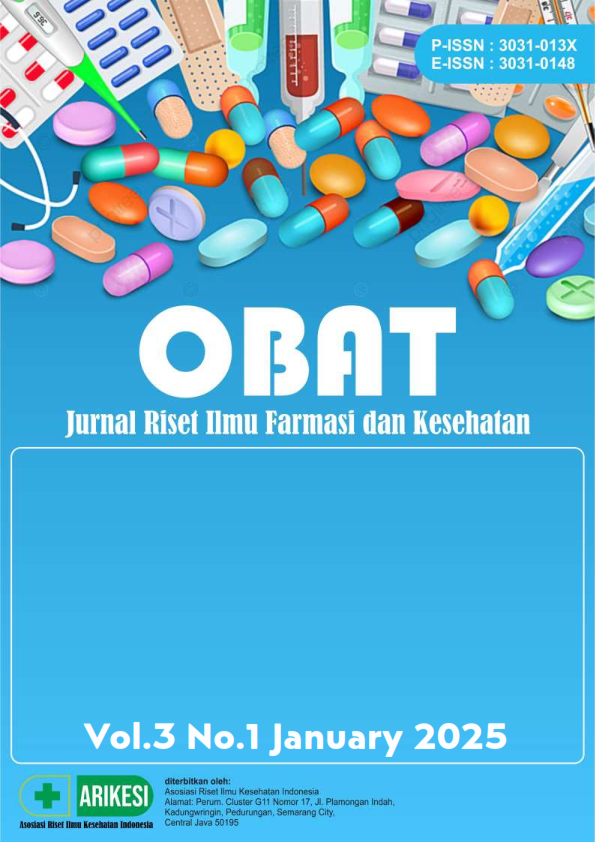Dehydroepiandrosterone Sulfate Deficiencies as Independent Predictors of Increased Coronary Artery Disease in Men with Type II Diabetes Mellitus
DOI:
https://doi.org/10.61132/obat.v3i1.984Keywords:
Diabetes , Dehydroepiandrosterone Sulfate, Insulin, Lipid, ComplicationAbstract
The adrenal cortex synthesis the steroid hormone dehydroepiandrosterone (DHEA), has a significant effect on diabetes mellitus. Our study targeted to estimate the relationship between serum levels of DHEA sulphate (DHEAS) and the risk of CAD complication for T2DM in men. Ninety Iraqi male subjects were divided into three groups. Each group has thirty people: thirty people type 2 with diabetes mellitus, thirty person type 2 diabetes mellitus patients with CAD complications, and the control group has thirty healthy people. A significant decrease (p<0.01) of DHEAS, was observed in T2DM with CAD (120.8 µg/dl) compared to both T2DM (141.26 µg/dl) and the control group (239.86 µg/dl). Meanwhile, an increased coronary risk index in T2DM with CAD (10.68) compared to both T2DM (7.56) and control group (4.41) was observed. These findings were confirmed by the negative correlation of DHEAs with coronary risk index. We suggested that a decreased level of DHEAS value may be a beneficial sign for future CAD in patients with T2DM.
Downloads
References
Aminian, B., Omrani, G., & Ostovan, M. (2000). Correlation between dehydroepiandrosterone sulfate (DHEA-S) and coronary artery disease.
Aoki, K., & Terauchi, Y. (2018). Effect of dehydroepiandrosterone (DHEA) on diabetes mellitus and obesity. J. V. Hormones, 108, 355-365.
Aronson, D., & Edelman, E. R. (2014). Coronary artery disease and diabetes mellitus. Cardiology Clinics, 32(3), 439-455.
Brahimaj, A., Muka, T., Kavousi, M., Laven, J. S., Dehghan, A., & Franco, O. H. (2017). Serum dehydroepiandrosterone levels are associated with lower risk of type 2 diabetes: The Rotterdam Study. Diabetologia, 60(1), 98-106.
Cavan, D., Harding, J., Linnenkamp, U., Makaroff, L., Magliano, D., Ogurtsova, K., & Shaw, J. (2016). Diabetes and cardiovascular disease.
Cersosimo, E., Triplitt, C., Solis-Herrera, C., Mandarino, L. J., & DeFronzo, R. A. (2000). Pathogenesis of type 2 diabetes mellitus. Endotext, 12-16.
Conkbayir, C., Burak, A., & Ökçün, E. B. (2015). Lipid variables related to the extent and severity of coronary artery disease in non-diabetic Turkish Cypriots. Iranian Journal of Public Health, 44(9), 1196.
Ding, E. L., Song, Y., Malik, V. S., & Liu, S. (2006). Sex differences of endogenous sex hormones and risk of type 2 diabetes: A systematic review and meta-analysis. JAMA, 295(11), 1288-1299.
Ding, E., Song, Y., Manson, J., Rifai, N., Buring, J., & Liu, S. (2007). Plasma sex steroid hormones and risk of developing type 2 diabetes in women: A prospective study. Diabetologia, 50, 2076-2084.
Goldman, N., & Glei, D. A. (2007). Sex differences in the relationship between DHEAS and health. The Journals of Gerontology Series A: Biological Sciences and Medical Sciences, 42(10), 979-987.
Hadaegh, F., Khalili, D., Ghasemi, A., Tohidi, M., Sheikholeslami, F., & Azizi, F. (2009). Triglyceride/HDL-cholesterol ratio is an independent predictor for coronary heart disease in a population of Iranian men. Nutrition, Metabolism & Cardiovascular Diseases, 19(6), 401-408.
International Diabetes Federation. (2015). Atlas, 7th ed.. International Diabetes Federation.
Kalyani, R. R., Franco, M., Dobs, A. S., Ouyang, P., Vaidya, D., Bertoni, A., Gapstur, S. M., & Golden, S. H. (2009). The association of endogenous sex hormones, adiposity, and insulin resistance with incident diabetes in postmenopausal women. The Journal of Clinical Endocrinology and Metabolism, 94(11), 4127-4135.
Kazemi, T., Hajihosseini, M., Moossavi, M., Hemmati, M., & Ziaee, M. (2018). Cardiovascular risk factors and atherogenic indices in an Iranian population: Birjand East of Iran. Clinical Medicine Insights: Cardiology, 12, 1179546818759286.
Leighton, B., Tagliaferro, A. R., & Newsholme, E. A. (1987). The effect of dehydroepiandrosterone acetate on liver peroxisomal enzyme activities of male and female rats. The Journal of Nutrition, 117(7), 1287-1290.
Liu, L., Li, Y., & Sun, C. (2015). The metabolic change of serum dehydroepiandrosterone sulfate, free fatty acids and desaturase activity in isolated post-challenge hyperglycemia. Stem Cell Research & Therapy, 5, 291.
Ogurtsova, K., da Rocha Fernandes, J., Huang, Y., Linnenkamp, U., Guariguata, L., Cho, N. H., Cavan, D., Shaw, J., & Makaroff, L. (2017). IDF Diabetes Atlas: Global estimates for the prevalence of diabetes for 2015 and 2040. Diabetes Research and Clinical Practice, 128, 40-50.
Słowińska-Srzednicka, J., Zgliczyński, S., Ciświcka-Sznajderman, M., Srzednicki, M., Soszyński, P., Biernacka, M., Woroszylska, M., Rużłło, W., & Sadowski, Z. (1989). Decreased plasma dehydroepiandrosterone sulfate and dihydrotestosterone concentrations in young men after myocardial infarction. Atherosclerosis, 79(2-3), 197-203.
Tenenbaum, A., Motro, M., Fisman, E. Z., Schwammenthal, E., Adler, Y., Goldenberg, I., Leor, J., Boyko, V., Mandelzweig, L., & Behar, S. (2004). Peroxisome proliferator–activated receptor ligand bezafibrate for prevention of type 2 diabetes mellitus in patients with coronary artery disease. Circulation, 109(18), 2197-2202.
Veronese, N., Trevisan, C., De Rui, M., Bolzetta, F., Maggi, S., Zambon, S., Corti, M. C., Baggio, G., Perissinotto, E., & Crepaldi, G. (2016). Serum dehydroepiandrosterone sulfate and risk for type 2 diabetes in older men and women: The Pro.VA Study. Canadian Journal of Diabetes, 40(2), 158-163.
Veronese, N., Trevisan, C., De Rui, M., Bolzetta, F., Maggi, S., Zambon, S., Corti, M. C., Baggio, G., Perissinotto, E., & Crepaldi, G. (2016). Serum dehydroepiandrosterone sulfate and risk for type 2 diabetes in older men and women: The Pro.VA Study. Canadian Journal of Diabetes, 40(2), 158-163.
Yang, S.-H., Du, Y., Li, X.-L., Zhang, Y., Li, S., Xu, R.-X., Zhu, C.-G., Guo, Y.-L., Wu, N.-Q., & Qing, P. (2017). Triglyceride to high-density lipoprotein cholesterol ratio and cardiovascular events in diabetics with coronary artery disease. The American Journal of the Medical Sciences, 354(2), 117-124.
Downloads
Published
How to Cite
Issue
Section
License
Copyright (c) 2025 OBAT: Jurnal Riset Ilmu Farmasi dan Kesehatan

This work is licensed under a Creative Commons Attribution-ShareAlike 4.0 International License.





